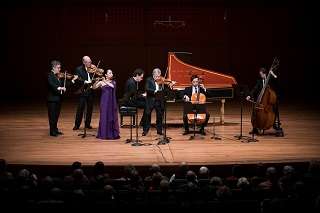|
Back
Might J.S. Bach Have Approved of These Performances? (2/2) New York
Alice Tully Hall, Starr Theater, Adrienne Arsht Stage
12/18/2022 -
Johann Sebastian Bach: Brandenburg Concertos, BWV 1046‑1051
Musicians from the Chamber Music Society of Lincoln Center

(© Cherylynn Tsushima)
Since the 1993‑94 season, it has become a tradition for the Chamber Music Society of Lincoln Center to present shortly before Christmas the complete set of Six Brandenburg Concertos, of which New York audiences apparently never have enough. And one can’t blame them, as this is the most remarkable set of “concertos for varied instruments” as Bach called those works which provide outstanding variety and quality. (The Brandenburg title came much later, more than a century after Bach’s death.) This is by and large joyous, good‑natured music and it is not hard to understand why it would be such a perennial favorite for holiday concert goers in New York or elsewhere.
As a rule, the Chamber Music Society in its programs doesn’t slavishly follow the tenets of H.I.P. (historically informed performances) and here we heard all six played on contemporary instruments with strings applying ample vibrato: when you play for nearly a thousand listeners, you better make sure they hear the real sound of any given instrument. Except CMS also employs the traditional, unamplified harpsichord which in this instance is very easily covered by all other instruments and is generally inaudible. In the times of J.S. Bach, this instrument was providing basso continuo, the base line, all necessary harmonies and general direction from the keyboard. But conversely, the instruments of that era were much softer and the whole venues would rarely exceed in size 20% of Alice Tully Hall’s stage.
Maybe, in order to alert the patrons that “we utilize such instruments”, the program started with the Concerto No.5 in D which calls for three solo instruments with an accompaniment of four additional strings. Our harpsichord player, who remained at the keyboards (he was using a two‑manual instrument) throughout the evening was Shai Wosner, very well known as an excellent, versatile, knowledgeable and probing pianist (and lately also an arranger of Beethoven Symphonies for piano trio). With his uncommon pianistic ability, there was no doubt that the virtuoso keyboard part in this concerto would be anything less than excellent. That is if/when we would be able to hear him. Alas, the famous solo cadenza – most likely the first such virtuoso cadenza in an instrumental concerto – sounded a bit undernourished because the hall is just unsuited for such instrument. In the second movement, a conversation of the three solo instruments, Mr. Wosner was almost inaudible and in the polyphonic final Allegro, the sound of harpsichord was again barely perceptible.
The performances of the whole set, played not in the “chronological” order, were spirited, lively, appealing and uniformly displaying instrumental excellence. The present day roster of musicians at CMS is the Who’s Who in the field of chamber music. We heard the veterans such as violinist Daniel Philips, violist Paul Neubauer, oboists Randall Ellis and Steven Taylor, and an array of younger, superb players, in forefront of New York chamber music freelancers. The Brandenburg Concertos offer a lot of highly demanding moments for string instruments, but also for French horns, oboes and first and foremost trumpet (here, in Concerto No.2 in F played on flugelhorn by Brandon Ridenour) and horns (in Concerto No.1 in F, Michelle Reed Baker and Julia Pilant). Thus, as far as superior playing, we were in good hands.
The Concerto No.3 in G always presents an issue of stylistic choice: unlike most of the concertos which are in three-movement form (No.1 has even five movements!) in this concerto, Bach didn’t differentiate between tutti and concertante, and wrote two outer Allegros leaving the middle movement as barely two chords. It’s unlikely that this was his intention: the second movement might have been either a solo fragment of a trio sonata, or arrangement of some other previously composed material. Some instrumental groups follow that historical practice – here, for once I regretted uttering not flattering sentiments about the H.I.P. – whereas CMS decided to allow Mr. Wosner to tinkle a few seconds long flourish which lead straight to the concluding Allegro. So that made me think that it would be nice if there was some token adherence to historically informed renditions rather than its total abandonment.
My suggestion of combining contemporary instruments and the large venue would be to either abandon the presence of harpsichord, which now serves as a visual object, or have it gently amplified, so at least it can be heard. A few days after having heard both of the concerts commented on in this review and the previous review, I had a chance to hear so‑called “Encore performance”, a recorded video of those events, offered to CMS patrons who either want to hear it again or who couldn’t attend in the first place. My hopes to alter my mind after hearing the versions captured by the microphones were thwarted. Even the professional recordings were not able to compensate for some of the balance problems described.
See you next year for yet another edition of Six Brandenburg Concertos, no doubt!
Roman Markowicz
|